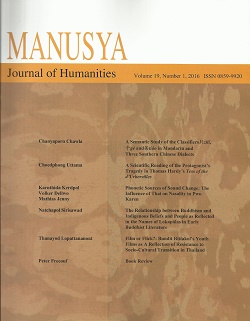Title : Film or Flick?: Bundit Rittakol’s Youth Films as A Reflection of Resistance to Socio-Cultural Transition in Thailand
Author(s) : Thanayod Lopattananont
Pages : 83-106
Abstract in English : Based on the theory that the film medium
is of high value in reflecting socio-cultural
matters, this research studied ten youth
films directed by Bundit Rittakol during
the 1980s-2000s in order to provide an
understanding of how his films can be
associated with the socio-cultural changes
occurring at that time. During the 1980s-
2000s, Thai society went through a period
of economic and social transition with the
adoption of a liberalized economy,
influenced by globalization and
democratization.
Many mainstream media outlets have
provided content that has tended to
support these socio-cultural changes, but
Bundit Rittakol’s youth films speak against
this transition as can be interpreted from
the themes that can be found in the films.
The first theme is the projection of the
central youth characters having what many
consider to be ‘desirable’ characteristics,
mostly in conformity to traditional Thai
behavior and rejecting the changing
lifestyle of that time. The second theme
concerns the negative portrayal of modern
society in which elements indicative of
socio-economic modernism and change
are associated with characters in
antagonistic roles or actions or events that
result in unfavorable consequences. The
final theme stresses what Bundit deemed
to be positive images of mainstream
Thainess, such as an idealized agricultural
lifestyle or strong faith in Buddhism. At
times, specific cultural contexts are
depicted in association with key
characters as if to remind the audience of
the Thai identity from a traditional
perspective, meaning that Bundit chose to
not compromise with the changes that
were predominant in society at that time.
Therefore, it can be concluded that his
youth films provided a view that countered
the impact of globalization by using a
localization of images as a reflection of
resistance.


